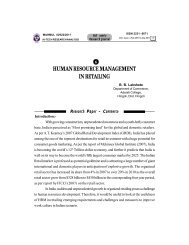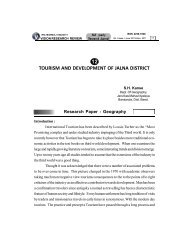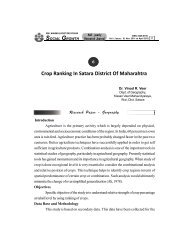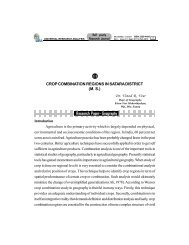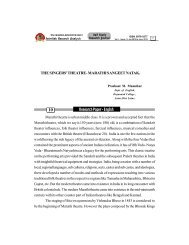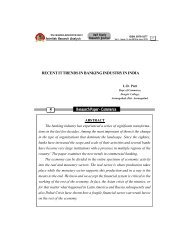A Geographical Study Of Food Grain Cropping Pattern
A Geographical Study Of Food Grain Cropping Pattern
A Geographical Study Of Food Grain Cropping Pattern
You also want an ePaper? Increase the reach of your titles
YUMPU automatically turns print PDFs into web optimized ePapers that Google loves.
UNIVERSAL RESEARCH ANALYSIS<br />
Half yearly<br />
Research Journal<br />
RNI. MAHMUL 13/2/2010 ISSN 2229-4406<br />
Vol. I , Issue :I I I, Sept. 2011 to Feb. 2012<br />
area of the region. The area under this crop largely (above 4 %) increased in Malshiras<br />
and Sangola tahsils whereas it increased to some extent in Pandharpur (2.34 %) Mohol<br />
(0.87 %) and Barshi (0.96 %). The area under this crop decreased in Northeastern and<br />
Eastern tahsil of the district because in this area irrigation is not well developed.<br />
5) Rice<br />
Rice is most commonly known by local name Bhat. It is the most common<br />
crop in a tropics. The botanical name of rice is oriza sativa. Rice is predominantly a rain<br />
fed crop. Rice ranks fifth among the crops grown in the district and accounts for a smaller<br />
aerial coverage. The main improved varieties grown in the region are IR8, Jaya, Suhasini,<br />
Karjat 184, Ratnagiri 24 etc which give better yields.<br />
Environmental Requirements :-<br />
Rice is a tropical monsoon crop requiring high temperature and high rainfall.<br />
Distribution of rice depends on agro climatic conditions. The climate of the area plays<br />
a more important role than soil in production of rice.<br />
Spatial Distribution :-<br />
In the reference year 2004/05, rice was grown more or less in all talukas of the<br />
district. <strong>Of</strong> these high i.e. only above 0.50 percent of the net sown area was covered in<br />
Akkalkot, South Solapur and Malshiras. The remaining area under rice was very low i.e.<br />
only below 0.50 percent of the net sown area.<br />
Temporal Analysis :-<br />
During the period under consideration, a very little change has taken place in the<br />
study region as shown in Fig No 4.13 and Table No 4.12. In 1990-91, rice covered<br />
0.35 percent of the net sown area, it slightly decreased in 2004-05 and covered an<br />
area of 0.34 % of the net sown area. In general, the area under rice decreased in all<br />
talukas except Madha, Barshi, South Solapur and Mangalwedha tahsils.<br />
CONCLUSION<br />
<strong>Food</strong>grains like jowar, wheat, Maize, bajara and rice crops occupied maximum<br />
area, i.e., 72.23 % in 1991/92 and in 2004/05 it was 66.07 % out of the agriculture<br />
area. Jowar is the most important crop of the study region. Jowar crop occupied<br />
maximum area than other crops. There is slight decrease in area during investigation<br />
6 7



